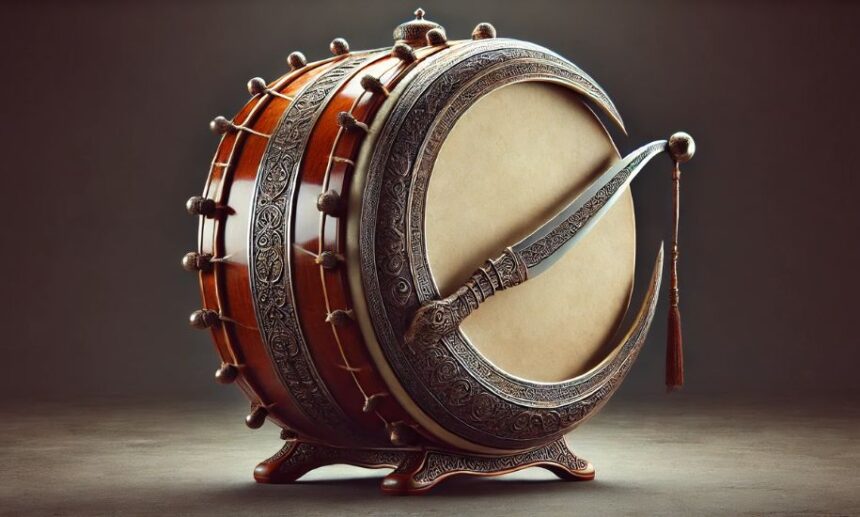The “scimitar drum” is an intriguing and rare musical instrument that has captured the attention of music enthusiasts and historians alike. Known for its distinctive shape and mesmerizing sound, the scimitar drum holds a unique place in the world of percussion instruments. In this article, we will delve into the origins, design, uses, and cultural significance of the scimitar drum. Welcome to another insightful piece brought to you by Market Blick.
The Origins of the Scimitar Drum
The scimitar drum takes its name from its resemblance to the scimitar, a curved sword historically used in the Middle East, North Africa, and South Asia. This instrument is believed to have roots in ancient civilizations where music played a crucial role in rituals, celebrations, and storytelling. The scimitar drum’s origins are tied to cultures that emphasized the connection between music and spirituality.
Design and Structure of the Scimitar Drum
The design of the scimitar drum is as distinctive as its name suggests. Its body often features a curved, crescent-like shape, mimicking the outline of a scimitar sword. Crafted from materials such as wood, metal, or a combination of both, the drum is typically adorned with intricate carvings or decorative patterns that reflect the culture it originates from.
The drumhead is made of animal hide or synthetic materials, stretched tightly to produce a resonant tone when struck. The size and curvature of the drum can vary, influencing its sound and the techniques used to play it.
How the Scimitar Drum is Played
Playing the scimitar drum requires skill and an understanding of its unique shape and acoustic properties. Percussionists use their hands or specialized mallets to strike different areas of the drumhead, producing a range of tones. The curved structure allows for diverse sound modulation, making the scimitar drum versatile for both rhythmic patterns and melodic expressions.
Musicians often incorporate the scimitar drum into ensembles or solo performances, using it to create dynamic and captivating rhythms. Its sound is characterized by deep, resonant bass tones and sharp, clear highs, making it suitable for a variety of musical genres.
Cultural Significance of the Scimitar Drum
The scimitar drum holds deep cultural significance in the regions where it originated. It has been used in ceremonial contexts, including religious rituals, weddings, and festivals. The drum’s unique design often symbolizes strength, spirituality, and artistic expression, making it a cherished artifact in cultural heritage.
In modern times, the scimitar drum has found its way into contemporary music, blending traditional and modern styles. Musicians and composers are drawn to its distinctive sound and aesthetic appeal, showcasing it in fusion genres and experimental compositions.
The Role of the Scimitar Drum in Modern Music
The scimitar drum’s versatility has allowed it to transcend traditional boundaries and enter the realm of modern music. Percussionists and composers are increasingly incorporating this instrument into their work, exploring its potential for creating innovative soundscapes. From world music ensembles to solo performances, the scimitar drum continues to inspire musicians with its unique characteristics.
Craftsmanship Behind the Scimitar Drum
Creating a scimitar drum is a meticulous process that requires skilled craftsmanship. Artisans carefully select materials, ensuring that the drum’s body and drumhead complement each other to produce optimal sound quality. The intricate carvings and decorations often reflect cultural motifs, adding to the drum’s aesthetic and historical value.
Each scimitar drum is a testament to the artisan’s dedication and expertise, making it not only a musical instrument but also a work of art. Collectors and musicians alike value these drums for their beauty and functionality.
Why the Scimitar Drum Stands Out
The scimitar drum stands out among percussion instruments due to its:
- Distinctive Shape: The curved, scimitar-like design sets it apart from conventional drums.
- Rich Sound: Its ability to produce a wide range of tones makes it versatile for various musical styles.
- Cultural Heritage: The drum’s historical and cultural significance adds depth to its appeal.
- Artistic Craftsmanship: The intricate designs and decorations make each scimitar drum unique.
Conclusion: The Timeless Appeal of the Scimitar Drum
The scimitar drum is more than just a musical instrument; it is a symbol of cultural heritage, artistic expression, and musical innovation. Its unique design, rich history, and captivating sound continue to inspire musicians and audiences worldwide. As we explore the fascinating world of the scimitar drum, it’s clear that this instrument holds a special place in both traditional and contemporary music.
At Market Blick, we celebrate the diversity and beauty of instruments like the scimitar drum, highlighting their importance in preserving cultural traditions and inspiring artistic creativity. The scimitar drum’s timeless appeal ensures that it will remain a cherished part of the musical landscape for generations to come.







